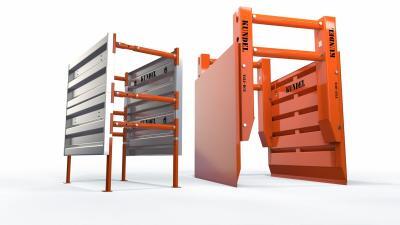An Access Chamber, also known as a utility chamber or service chamber, is an underground structure designed to provide access to various utility lines for maintenance, repairs, and installation purposes. These chambers are commonly used in urban areas where multiple utility services, such as electricity, telecommunications, water, gas, and sewage, are required.

Trench Safety Equipment: Trench Boxes Manhole Boxes, Bedding Boxes, Road Plates
Here are some key points about Access Chambers:
- Purpose: Access Chambers are primarily built to provide easy and convenient access to utility lines that are buried underground. They serve as entry points for utility workers to carry out inspections, repairs, upgrades, and installations without the need for extensive excavation.
- Location: Access Chambers are typically located strategically along utility corridors or at key points in a network. They are often situated near roads, sidewalks, or utility easements to ensure accessibility and minimize disruption to the surrounding area.
- Structure: Access Chambers are constructed using durable materials such as concrete or precast concrete. The chambers are designed to withstand the weight of the earth above them and any potential traffic loads from vehicles passing over them. They are usually rectangular or cylindrical in shape and can vary in size depending on the number and size of utility lines they accommodate.
- Access Points: Access Chambers feature one or more access points, which can be covered with a heavy lid or grate. These access points are typically flush with the ground surface, allowing easy entry for utility workers. The lids or grates are designed to be removable to facilitate maintenance activities.
- Utility Line Connections: Within an Access Chamber, various utility lines are interconnected. These lines can include electrical cables, telecommunications cables (fiber optic, copper, etc.), water pipes, gas pipelines, and sewer lines. The chamber acts as a hub where these lines converge, allowing utility workers to access and manipulate them as needed.
- Safety Features: Access Chambers are equipped with safety features to ensure the well-being of workers and the general public. These features may include ventilation systems to mitigate the accumulation of hazardous gases, lighting for visibility, and safety barriers to prevent unauthorized access.
- Maintenance and Inspections: Regular maintenance and inspections of Access Chambers are necessary to ensure the proper functioning of utility services. Utility companies or local authorities are responsible for conducting routine checks, cleaning, and repairs as required.
- Integration with Other Infrastructure: Access Chambers are often designed to integrate with other urban infrastructure. For example, they may be coordinated with stormwater drainage systems to prevent water infiltration and flooding. In some cases, Access Chambers can also accommodate other equipment, such as traffic control devices or fiber optic distribution points.
Overall, Access Chambers play a crucial role in providing access to utility lines, allowing efficient maintenance, repairs, and upgrades. They contribute to the smooth operation of essential services while minimizing disruptions to the surrounding environment.

